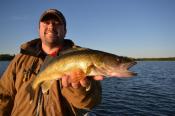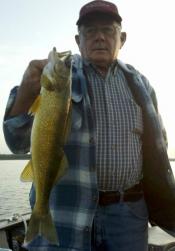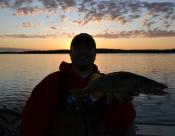 The bite is tough. Food is abundant. Bugs, minnows, hatchlings, and creepy crawlies of all types stock the walleye buffet at your local lake during the dog-days of August. The best days of walleye fishing are behind us….and ahead of us. Choose anytime to fish but August they say. Well I say it too. I’ll be the first to admit that I stack my fishing adventures more heavily towards the early and later parts of the season. But that’s not to say there aren’t fish to be had during this time period. They’re there. Fat and finicky, in fairly predictable locations. The trick isn’t just finding them during this time of year, which can be hard enough for walleyes of any season. This time of year, a premium goes to finding active fish, or fooling inactive ones. Most times it’s a healthy combination of both.
The bite is tough. Food is abundant. Bugs, minnows, hatchlings, and creepy crawlies of all types stock the walleye buffet at your local lake during the dog-days of August. The best days of walleye fishing are behind us….and ahead of us. Choose anytime to fish but August they say. Well I say it too. I’ll be the first to admit that I stack my fishing adventures more heavily towards the early and later parts of the season. But that’s not to say there aren’t fish to be had during this time period. They’re there. Fat and finicky, in fairly predictable locations. The trick isn’t just finding them during this time of year, which can be hard enough for walleyes of any season. This time of year, a premium goes to finding active fish, or fooling inactive ones. Most times it’s a healthy combination of both.
 This past week, I got the chance to fish big and beautiful Leech Lake, as well as a handful of new walleye lakes within an hour’s drive. What we had going for us was fairly stable weather, and more favorably yet, consistent wind. Fish were consistently placed on the west facing portions of every piece of structure we fished, with active and hungry fish waiting face-first on the most prominent piece of that structure, almost without fail. There were some days where we had a bit too much of that west wind, fishing on the east side of Leech lake, so we happily obliged by fishing several other area lakes for walleyes that still sported some walleye-chop, instead of just heavy-chop. As mentioned, finding fish was less difficult for us than finding active fish. We put a heaping handful of offerings in front of many fish these past few days, but got bit only when everything was perfect. Making the stars align meant paying attention to small details that tend not to matter as much when the bite is hot, but were everything in determining our success last week.
This past week, I got the chance to fish big and beautiful Leech Lake, as well as a handful of new walleye lakes within an hour’s drive. What we had going for us was fairly stable weather, and more favorably yet, consistent wind. Fish were consistently placed on the west facing portions of every piece of structure we fished, with active and hungry fish waiting face-first on the most prominent piece of that structure, almost without fail. There were some days where we had a bit too much of that west wind, fishing on the east side of Leech lake, so we happily obliged by fishing several other area lakes for walleyes that still sported some walleye-chop, instead of just heavy-chop. As mentioned, finding fish was less difficult for us than finding active fish. We put a heaping handful of offerings in front of many fish these past few days, but got bit only when everything was perfect. Making the stars align meant paying attention to small details that tend not to matter as much when the bite is hot, but were everything in determining our success last week.
 Leech has always been a great place to pull spinners for me. Vast amounts of structure dictate covering some water. So cover water we did, and harvested waypoints on our traditional milk-runs every time a rod bent over in the holder. The best of the best got a harder look, and we picked apart some more intricate structure slowly with live-bait rigs. Hammered silver and gold with crawlers took most of the spinner fish, and a standard 6-8’ rig with a plain hook and chartreuse bead with half a crawler was the favored rig-offering. 16-22 FOW depending on time of day, with low-light periods seeing most of the fish. Nothing spectacular sounding, but the application was much more difficult than it sounded. Fish were following on the graph, stalking, just waiting for a zag instead of a zig. Holding the rod and imparting some subtle action to the spinners got yours bit 2 to 1 over leaving it in the holder.
Leech has always been a great place to pull spinners for me. Vast amounts of structure dictate covering some water. So cover water we did, and harvested waypoints on our traditional milk-runs every time a rod bent over in the holder. The best of the best got a harder look, and we picked apart some more intricate structure slowly with live-bait rigs. Hammered silver and gold with crawlers took most of the spinner fish, and a standard 6-8’ rig with a plain hook and chartreuse bead with half a crawler was the favored rig-offering. 16-22 FOW depending on time of day, with low-light periods seeing most of the fish. Nothing spectacular sounding, but the application was much more difficult than it sounded. Fish were following on the graph, stalking, just waiting for a zag instead of a zig. Holding the rod and imparting some subtle action to the spinners got yours bit 2 to 1 over leaving it in the holder.
 Details were more important yet on the other lakes. You come to take for granted the high-resolution Lakemaster contours when you fish big bodies of water most often. Going to a lake that hasn’t been surveyed at all makes you feel a bit naked at first, but there’s ways to overcome that as well. With smaller lakes comes less open water for there to be off-shore structure. That being the case, most of our fish held to what structure was there, namely underwater points extending from shore with the most productive ones not necessarily following the outline of the shore itself. Read that as underwater points that extended from a rather straight and featureless piece of shoreline. These are the ones that are harder for everyone else to find, so they’re the most valuable. However, using your electronics at high speed (25-35mph on my boat), cruise off of shore in 18-24 FOW, looking for the bottom to rise and bottom color to indicate hard bottom. Drop a waypoint and continue on your way until you’ve “mapped” the irregular structure. Come back and sweep it in all directions with your electronics, looking for pods of fish and the way this structure lays out, paying particular attention to windblown portions of the structure, as well as small irregular portions of the structure itself. These small areas on the larger underwater points were gold mines for us, but fell more into the “have-to-trick-them” category than the “pick-off-the-active-fish” one. Not all pieces of structure are created equal, and here’s where the Marcum 620 came in handy. Where there were other signs of life, walleyes were there aplenty. Clam shells, crayfish, minnows, perch…..all were indicators of the walleyes we knew we’d catch. Some of the most beautiful looking rock/sand/mud transitions that were lifeless held none.
Details were more important yet on the other lakes. You come to take for granted the high-resolution Lakemaster contours when you fish big bodies of water most often. Going to a lake that hasn’t been surveyed at all makes you feel a bit naked at first, but there’s ways to overcome that as well. With smaller lakes comes less open water for there to be off-shore structure. That being the case, most of our fish held to what structure was there, namely underwater points extending from shore with the most productive ones not necessarily following the outline of the shore itself. Read that as underwater points that extended from a rather straight and featureless piece of shoreline. These are the ones that are harder for everyone else to find, so they’re the most valuable. However, using your electronics at high speed (25-35mph on my boat), cruise off of shore in 18-24 FOW, looking for the bottom to rise and bottom color to indicate hard bottom. Drop a waypoint and continue on your way until you’ve “mapped” the irregular structure. Come back and sweep it in all directions with your electronics, looking for pods of fish and the way this structure lays out, paying particular attention to windblown portions of the structure, as well as small irregular portions of the structure itself. These small areas on the larger underwater points were gold mines for us, but fell more into the “have-to-trick-them” category than the “pick-off-the-active-fish” one. Not all pieces of structure are created equal, and here’s where the Marcum 620 came in handy. Where there were other signs of life, walleyes were there aplenty. Clam shells, crayfish, minnows, perch…..all were indicators of the walleyes we knew we’d catch. Some of the most beautiful looking rock/sand/mud transitions that were lifeless held none.
Live bait rigging, slowly was the key to success on these lakes. 0.3mph, long snells (8-10 feet), small plain colored hooks, with lively leeches were all essential parts of the game. Miss one of the above and you might as well be fishing for walleyes in the Pacific. We tried bobbering on the fish, but they were so concentrated, they were actually easier to find by dragging slowly in a small area till you connected. Small turns of the boat, where the inside rod literally paused in place got the majority of the bites. Fish chased here too, and imparting some action on the bait was more productive that the basic motionless hold that’s more common. Bites were basically phantom. Most were just light pressure, almost like a snag. Pick up the sinker slowly until the hook either gave from the rock it was on, or gently tugged back. Drop the sinker in the rocks and you’d sometimes spook the fish. Set it down gently, give the fish a 5-count and sweep, and you were usually rewarded. Again, low-light periods saw most of the fish, and also particular zones of activity. Catch them on their climb out of the depths at dusk, or on the retreat back at dawn, and you’d connect in 17-20 FOW. Too early or too late, and they’d be shallower or deeper; and MUCH more reluctant to bite.
So there you have it. Lots of fun, and plenty of fish to be had, with just a few more details making the difference between bit or bummed.
Joel
Here’s some more pics. From left to right:
-after sunset
-good morning for eaters
-hand-landing – forgot the net that morning
-another sunrise fish
Joel
Great job catching Walleyes when it seems the walleyes were in a nuetral or even negative mood. Joel you mentioned low light conditions had fish more active. Here on Rainy lake often times low light can actually be tough and our better fishing can be focused after our stained waters have some light penetration. Do you think Leech offers a night bite, and if so do you believe at times like in the “Dog Daze of August” they may feed mainly after the sun goes down??
I also think it is very cool you were able to visualize bottom content changes along with signs of life with your Marcum underwater Camera. Although we aren’t able to see very far in water 30 feet+ I plan on bringing one out while I pinpoint house locations for this winters ice fishing.
Chris:
Great point regarding the night bite. We actually were driving up a bit later during mid-week, watching the massive moonrise and groaning about the possibility that we’d be ONLY fishing at night. I’m not so sure about Leech, but we fished another body of water that was ultra clear, and I’m almost positive there would be a great night bite on that lake with only a little bit of moonlight. If timed right, I’m sure you could do better than we did on clear lakes with good deep weedlines.
So many people think of the underwater camera as an ice-only piece of equipment. The advantage in open water is that obviously you can cover an incredibly larger amount of water during the summer. It was a difference maker for us. Like I mentioned, there needed to be life on these rock and sand bars, or they didn’t hold fish, plain and simple. Find it, and you knew it was worth fishing more slowly.
One tip when using the camera, a 10-15 mph wind is about perfect. Literally pull the boat up to the head of the structure you wish to view, and just let the wind drift you evenly across it while you focus on the camera display. Even with the trolling motor, you tend to be a bit herky-jerky, making viewing esp. at any distance fairly difficult.
Joel
Nice report!!
Nice report Joel and great advice on the importance of fishing structure that is exposed to the same direction as the wind.
and great advice on the importance of fishing structure that is exposed to the same direction as the wind. 
In regard to targeting depths in mid August, where does a guy start? Do water temps play a factor? The forage base of that lake? Water clarity? Structure?
Great read and pics Joel

Great report Joel! Granny Leech has a KILLER nite bite, September fullmoon will be he maiden trip with my new rig, its a garenteed slam dunk! Last trip they didnt go till 1am but from 1 to 230 put 21 fish in the boat for me. SHALLOW
Great Job and report Joel




I love golden walleyes!!
They make such beautiful photos!
I love the “low light eye” pic


There’s some good information right there Joel
Good questions Brad. I don’t have all the answers, but I know where to start looking. I like to divide fish up into groups based on where they spend most of their time. There’s always going to be fish roaming the basin with a good tullibee or other baitfish population. Main-lake structure will also hold fish in areas with good bottom transitions from rock/sand, sand/mud, etc. These were the fish we picked on for the majority of our trip for a number of reasons. There’ll also be a weed bite in many of these lakes, but in my experience, August might not be the best time to target these shallower fish.
With a big body of water like Leech, finding fish in the basin is an investment to me. You might put in sizeable time finding them, but when you do, you’re likely to have the larger fish in the lake all to yourself. With less time to fish than I would’ve liked, we stuck to some obvious wind-blown breaks in that 18-20FOW range that I typically find walleyes on through most of the summer.
So for the most part, it was a combination of techniques I’m confident in, coupled with convenience in finding them that made this trip a success.
Joel
Would LOVE to try this. I’ve trolled Mille Lacs for years, but Leech sounds like a new adventure and much less crowded. You might find me up there this fall!
Joel